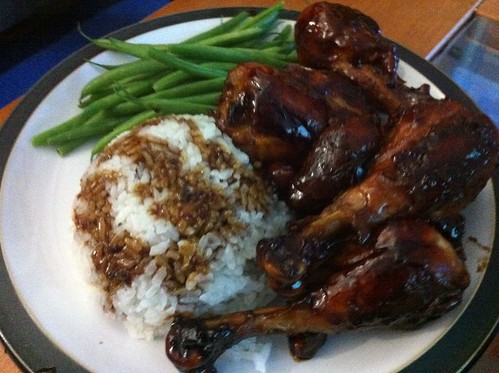Doesn't that look good!? It really was, and I didn't have to go to the store for a single ingredient! Tonight, I defrosted a couple of steaks. With those steaks (from Omaha Steaks), I received some frozen stuffed loaded baked potatoes. I'm not one to purchase something like that because I'd much rather make it myself, from scratch, but they came with the package, and we had two left, so I threw those in the oven, and also blanched the other half of that bag of haricots verts. Another dinner without a need for a trip to the market!
I took some frozen sauce (of some sort - I really should start labeling) out of the freezer, along with a few chicken breasts for tomorrow's meal, too. I'm determined to use everything, before I go out and buy more. It may be a sort of winter cleaning - I've definitely been on that sort of kick lately. All this using leftovers brings me to today's lesson at "culinary school."
In Menus and Recipes, I expected to learn about planning dishes, and adapting them to a professional kitchen format, and I certainly did learn about that. However, who would have thought the the majority of this chapter would be math equations!? I am not a math person, I've never BEEN a math person, and I never intended to BE a math person, but surprisingly, the equations learned in this chapter actually made a bit of sense to me. I had to read them a few times, and the examples definitely helped, but I think I am starting to understand how a restaurant or catering company can calculate prices based on portions and weights. I won't bore you with every equation I learned (unless of course, you'd like to know more - comment on this post and let me know - I can always write another post) but I would like to talk about one that I found especially interesting.
The calculation for usable trim equation helps determine how much money will be saved and put to use if the trimmings from one mise en place ingredient is used in another place in the kitchen. For instance, when a carrot is peeled, trimmed and diced, there are leftovers - the peelings, any scraps that don't fit the shape and size of the dice needed, etc. Well, is that just thrown out? In my kitchen, until now, most likely. What I didn't think about until now is that these trimmings are valuable product to a restaurant kitchen, and can be used in another place, to save money and time. The trimmings of a carrot can be used in a stock, since all the ingredients used to flavor that stock are strained out before use. What's the difference whether you use scraps of carrots, or a whole new carrot, when no one's going to be eating it anyway. Another example, which can be much pricier than a carrot, is meat. When meat is trimmed in order to get a great cut to serve, what happens to those trimmings? Well, they could be used in place of ground meat in certain situations, and could also be used to flavor a stock.
Example:
$0.106 (As purchased cost of carrots per ounce)
= $0.119 (value of usable carrot trim for soup per ounce)
0.89 (Yield percent for chopped carrots)
I'm determined to apply a version of this idea in my own kitchen. If I peel a carrot, I'm going to save those peelings for stock. Looking ahead in the book, I'm going to be making quite a few stocks and soups in the near future, so it'll be good to start stockpiling. I would like to minimize waste and maximize output, even in a kitchen that only feeds the two of us (and all my friends, most of the time!) When I make menus, I will try to maximize the use of each ingredient that I have to purchase, spreading it among a few different recipes on the same menu. If I can do it in my own kitchen, I can certainly do it in a professional kitchen of my own one day...
Some day!


